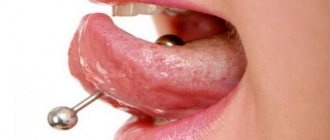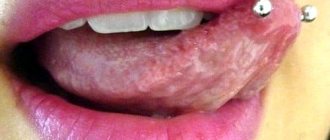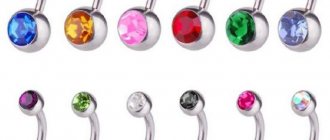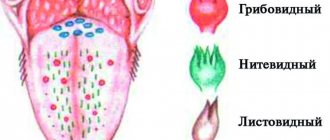The ancient ritual of sacrifice of the Mayan people and Australian aborigines has rapidly entered modern fashion. Information on how to pierce your tongue at home is available on the Internet. Knowledge of the rules, sequence of actions and methods of protection against inflammation and infections will help to carry out the procedure safely.
Whether it is worth piercing your tongue, for example, you need to decide for yourself, only knowing exactly the nuances of the procedure. Otherwise, it is better to get your tongue pierced in a professional salon, where specialists know exactly how to perform this mini-operation, how to numb the process as much as possible and not cause an infection.
Doubts and fears before the procedure
People who decide to have home piercings are overcome by doubts and fears regarding possible pain in the oral cavity. The use of analgesics will make the process painless, however, when their effect stops, the pain will remain until the wound is completely healed. Therefore, when asked whether it hurts to pierce your tongue, you can answer that it is quite tolerable. The procedure depends on personal sensitivity to pain and mood. The procedure can be compared to a cosmetic ear piercing.
Accurate knowledge of how to pierce the tongue is necessary. If the procedure is carried out at home, then the attitude towards hygiene and sterilization of piercing instruments should be increased. In this case, it will be possible to avoid infection and inflammatory processes, which are unlikely to be dealt with on your own; emergency medical attention will be required.
Why is the tongue pierced?
It is widely believed that tongue piercing is done for sexual pleasure, which the earring gives the partner, causing additional sensations. However, girls often get pierced simply for the sake of fashion or to self-identify with a group of people belonging to a specific subculture. Another reason is the desire to stand out, to become different from everyone else.
Tools
To pierce the tongue, you need a set of sterile instruments, including:
- decoration: a rigid rod consisting of a rod with a rounded cross-section, onto which elements are screwed on both sides: stones, cones, spikes. The jewelry is made of surgical steel, titanium, Teflon or gold. The rod comes with internal and external threads, its length ranges from 1.5 to 3.5 cm;
- a clamp for holding the tongue, instruments of this type are usually used by surgeons, the clamp is made of stainless medical steel;
- piercing catheter or cannulated instrument: a needle that is empty inside, made in different diameters. The needle is laser sharpened, so tongue piercing at home is performed with maximum comfort and safety. The diameter of the catheter should be larger than the diameter of the selected jewelry, then repeated manipulations will not be required;
- sterile gloves that will ensure a secure grip on instruments and protect against infections;
- preparations for disinfection: Miramistin or Chlorhexidine.
What is tongue piercing
This is a surgical operation, although short, but dangerous, which involves piercing the tongue with the subsequent insertion of a special earring - a barbell. Common decorations are vertical bars made of surgical steel or titanium. The earring is double, it can be seen both from above and from below. Another type, horizontal, is a frenulum piercing under the tongue. Making such a puncture is much easier - there is less blood, pain, healing is faster. Jewelry comes not only in the form of a barbell, but also a staple, a ring, a carnation.
Step-by-step instruction
Step-by-step instructions will tell you how to pierce your tongue correctly and almost painlessly. However, before studying it, it is important to know some rules for this mini-operation planned at home.
First you need to understand where, in what place you can pierce your tongue. Piercing is done exclusively on the tip of the tongue or strictly in its middle. If the puncture is made along the edges, then there is a high probability that the needle will get into large arteries, and it will be difficult to stop the bleeding.
If there are concerns that piercing your tongue will be painful, then you can resort to analgin or No-shpe. These drugs can make manipulation easier.
- Sterilize all instruments, including jewelry, with special products or medical alcohol.
- Rinse your mouth thoroughly using antibacterial or mild saline solutions.
- Wash your hands thoroughly with antibacterial soap, then put on sterile gloves.
- Holding your tongue with a clamp, mark the place for the puncture.
- Make a puncture with a hard movement. Using a catheter, the puncture is made from below, using a regular needle from above. Videos about how to pierce the tongue in one way or another can be found on the Internet.
- Insert the earring using a catheter or normal movement. The earring is inserted without delay, since within a few hours the wound will begin to heal and a new puncture will have to be made.
- Rinse your mouth thoroughly with an antiseptic.
Tongue piercing
How to pierce the tongue
It is preferable to get your piercing done at a salon as this procedure is considered surgery. In order to choose the right place for a puncture without damaging blood vessels and nerves, the doctor must have the appropriate qualifications. Tools and gloves use disposable or sterilized ones. The sequence of actions is as follows:
- The mouth is pre-treated with an antiseptic; sometimes Lidocaine is used for anesthesia.
- The tongue is grabbed and fixed with a special clamp, then pierced with a needle from the bottom up.
- Finally, jewelry is inserted into the puncture site.
Possible complications and problems
Knowing how to safely pierce your tongue at home can minimize unwanted consequences. However, they may still appear. If the puncture site is chosen incorrectly, the jewelry may not take root. The puncture site will constantly swell and hurt, creating inconvenience when eating.
In any case, the consequences of tongue piercing performed at home will be an uncomfortable sensation in the mouth for some time. For about two weeks, only soft and liquid food is taken. Diction is disrupted, decoration gets in the way and is difficult to get used to.
In some cases, the bar, constantly in contact with the teeth and gums, can knock off the enamel from the teeth and injure the gums.
How to care for a pierced tongue
Care involves treating the wound with antiseptic solutions such as Chlorhexidine, potassium permanganate or soda. For the first 2 weeks, rinse your mouth as often as possible, always after meals. After ten to fourteen days, instead of rinsing with an antiseptic, use a decoction of chamomile or calendula. Do not be overzealous so as not to deprive the natural antiseptic - saliva - of its protective properties. The barbell also requires care. For the first two weeks, brush it with a soft toothbrush. Afterwards, regularly remove the barbell, clean and disinfect it.
Care after a piercing
After a puncture, care should be aimed at speedy healing of the wound. The mouth constantly produces antimicrobial peptides that kill harmful bacteria. However, you should not rely on them alone; additional measures are also needed for healing.
- Avoid alcohol and smoking, as the tar contained in cigarettes and the ingredients in alcoholic beverages will delay the healing process.
- Avoid viscous, hard and spicy foods, fermented milk and sweet products.
- Rinse your mouth with warm saline solution and antiseptic Listerine or Miramistin.
- Postpone kissing for a while, as there is a risk of infection.
Understanding how to properly pierce your tongue will help you perform this small and, in every sense, rather risky operation successfully. The choice of where to hold it, at home or in a salon, remains with the person who wants to be unusual and sexy, standing out in the crowd. In any case, ensuring safety and maintaining health should be the deciding factors for a person who decides to get a piercing.
Does it hurt to pierce your tongue?
According to reviews from those who have undergone the operation, the puncture itself is a matter of seconds, quite tolerable. It will hurt later, during healing. The tongue is highly sensitive. Because this organ is in constant motion, with a wound in the middle, it will hurt until it heals completely. To reduce pain:
- have the operation performed by a trusted specialist;
- care for the wound;
- do not smoke;
- do not drink alcohol;
- talk less at first;
- Avoid hot, spicy foods.
Rod selection
A tongue piercing bar is a piercing tool consisting of a metal rod, the average width of which is 1.6 mm, as well as 2 fixing screws. In order to choose the right earring, which will allow you to avoid significant complications and discomfort when wearing, you should know what sizes and materials exist, and also be able to put on the jewelry correctly.
Size
The thickness and length of the metal product is selected based on the individual characteristics and preferences of the client. A standard size bar is a structure 16 mm long and 8 mm wide. The diameter of the wrap, the outer ball or stone, is also taken into account. When using a standard bar, the product does not protrude beyond the upper layers of the tongue. A correctly inserted structure practically does not move out and does not lead to deformation of tissue structures.
Tongue piercing rods
The client can choose any suitable size - from 5 mm to 40 mm, depending on preferences. Experts recommend inserting standard rods into the tongue, which will not cause any inconvenience.
The larger the diameter of the product, the more you will need to stretch the puncture site. Jewelry that is too large is characterized by severe discomfort when worn, so it is more difficult to get used to it. Rings or bars that touch the surface of the teeth can lead to rapid degradation of the enamel.
It is not recommended to use thin rods, as they are more likely to be displaced, which can cause severe stretching of the puncture, in some cases up to the size of the ear tunnel.
Materials
To eliminate possible suppuration or irritation, special attention must be paid to the choice of material. To constantly wear a barbell, experts recommend using gold or silver items, the chemical composition of which will not affect your health in any way.
Cheap metal structures, especially those coated with varnish or paint, will begin to oxidize and crack, which can cause the internal coating to remain inside the pierced area.
It is best to purchase products made of titanium, a material widely used in medical practice. This type of metal is better combined with external human tissues, therefore it does not lead to rejection, is not toxic, and is absolutely harmless to the body.
After direct tissue incision, it is best not to use medical metal, because the chances of developing suppuration in the tongue increase. It is better to use silver or gold inserts while the wound is healing.
Recently, barbells made of silicone, surgical steel and bioplastic have been gaining popularity, each of which has its own advantages and disadvantages. In this case, it is best to consult a specialist.
Designs
Small metal balls of simple shape or shiny rhinestones are best suited for girls. The multi-colored elements resembling thorns look quite interesting.
Curly piercing bars are gaining particular popularity, the images on which can be either brutal - bones, skulls, crosses, or feminine, in the form of hearts, stars or butterflies. Imagination and understanding of one’s own preferences play a big role. Some models are characterized by a special thread, which allows you to alternate different shapes on one rod.
Commonly used types of jewelry:
| Type of decoration | Description, advantages |
| Barbell | It is the most popular and safest option. The product is a straight rod, at the ends of which there are special balls that allow you to better secure the decoration. |
| Banana | A type of barbell that has a curved shape. Like the usual variation, this type of decoration also belongs to the classics. |
| Labret | The same rod, but at one end there is a cast base, and at the other there is a special thread for screwing on additional decoration. The variation is the easiest of all available. |
| Ring | It is an ordinary ring-shaped decoration, at the end of which there is a special ball that fixes the product on the tongue. |
| Barbell and ring | It is the most popular variety in the case of vertical piercing. |
Metal rods are often silver in color, with exceptions being acrylic, gold, and surgical steel, which can be found in black or gray. Cheaper models can come in different shades by adding paint or varnish, but such materials can cause a wide range of complications and discomfort in the tongue.
Many piercing experts point out that when choosing jewelry, it is better to pay attention to the classic barbell, which is characterized by a straight and elongated shape.
How to wear
The barbell is put on immediately after the puncture, which avoids further complications or damage while wearing. After approximately 3-4 weeks, the earring can be replaced with a new element.
Even after the wound has completely healed, during the process of removing or putting it on, it and the entire oral cavity must be treated with a liquid saline solution, and the jewelry itself must be treated with hydrogen peroxide.
The barbell must always be threaded with caution. It is better to do this from the bottom up, which will avoid many complications. In some cases, the earring may include a special clasp to which the balls are attached. This model is quite difficult to remove, so it is best to seek advice and help from a specialist.
If there are any difficulties in the process of putting on or removing the barbell, you should contact a piercer. Otherwise, the puncture site may tear, which significantly increases the risk of developing an inflammatory or purulent process in the mucous tissues of the oral cavity.
Contraindications
Tongue barbell piercing (you can choose a product in any specialized store or salon) has a number of contraindications for which it is not recommended to perform a piercing.
Main contraindications:
- Exacerbation of chronic diseases. The introduction of a foreign object into the mucosa can lead to the development of complications against the background of the existing pathological process. Refers to infectious or cold diseases, in the presence of which piercing can aggravate the course of the disease.
- Diseases that affect blood clotting. Incorrectly performed piercing can lead to the development of particularly dangerous complications for the entire body.
- Pregnancy. This is explained by the fact that during pregnancy, it is especially important to avoid any risk of infectious or bacterial contamination. Neglecting a contraindication can cause irreparable harm to the fetus.
- Presence of allergic reactions. The presence of certain allergens, as well as individual intolerance to the substance in the jewelry, can contribute to the rapid development of severe symptomatic manifestations, including anaphylactic shock.
Experts do not recommend piercing the tongue if the patient does not have free time for regular care of the mucous membrane, which includes the process of rinsing and washing the wound. If a person does not take care of his oral cavity, he may develop suppuration or inflammation of the upper tissue structures.
Tongue piercing in most cases requires adulthood or special permission from a parent. The absence of such a rule may indicate low professionalism of employees, so it is better to choose another establishment.
How much does a tongue piercing cost?
To make jewelry bring joy and not darken your life, go to a salon or medical facility. Many clinics offer tongue piercing services, here is an overview of the cost of the procedure in Moscow institutions:
| Name of institution | Cost, rubles |
| Family doctor | 1 800 |
| Etisel | 2 200 |
| World of beauty | 1 500 |
| Hippocratic Oath | 2 000 |
| EkaMed | 1 500 |
Types of needles
There is a wide variety of needles that have different diameters and purposes. Below are the types of piercing needles that are most often used for the procedure.
Designed for piercing the ears and nose. It is worth noting that these types of piercings are the most popular among many people. The instrument used to perform the puncture has an internal diameter of 0.8 mm.
This type of needle has diameters of 1.4 mm and 1.2 mm. These sizes also allow this needle to be used for nose and ear piercings. Nose piercing is carried out in different parts, for example, on the bridge of the nose or the tip, and have different decorations. Using this needle, the earlobe, cartilage, outer part of the ear or the helix of the auricle can be pierced.
It is a tool whose outer and inner diameters are 2 and 1.6 millimeters. With the help of such a needle it is convenient to pierce the eyebrows. The decoration can be placed in different places, for example, above the eyebrow, and at different angles. It is worth noting that the choice of location is determined not only based on individual wishes, but also on physiological characteristics.
Thanks to the sizes of 2 and 1.4 mm, piercings are carried out in the navel, tongue and nipples. Instruments for these types of piercings have a catheter that allows you to insert the jewelry into the hole.
This type of special needle is mainly used for setting tunnels. This is due to the size of the instrument, which has an outer diameter of 4 mm and an inner diameter of 3.8 mm. The procedure for installing tunnels involves making a hole for decoration, which will gradually stretch to the required size.
Piercing should be performed only with high-quality needles that are made of material that does not cause an allergic reaction or irritation. It is worth noting that not only the piercing process, but also the further healing of the wound depends on the instrument used.
Source











